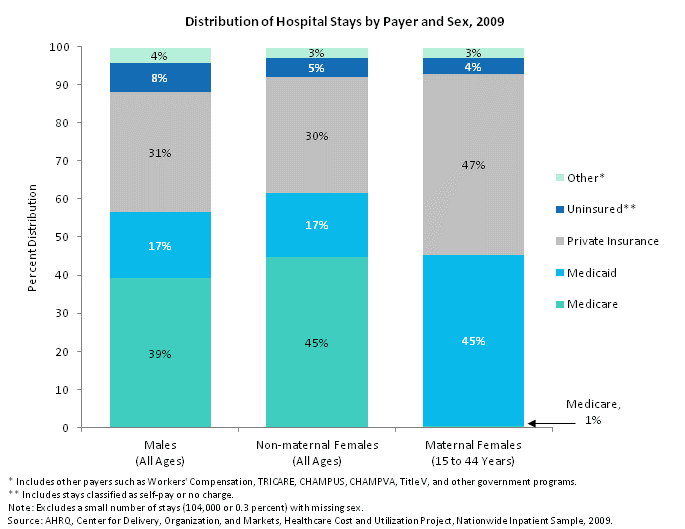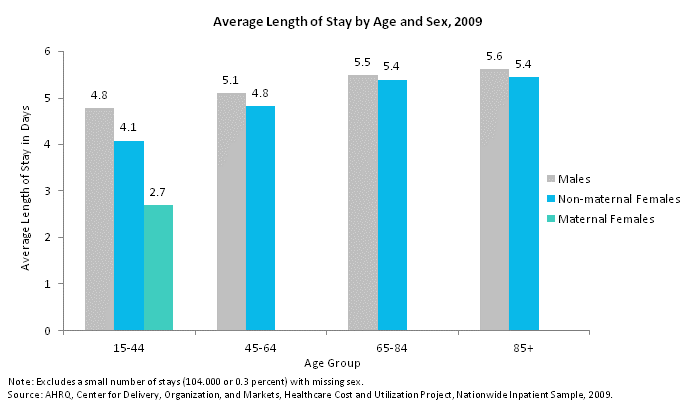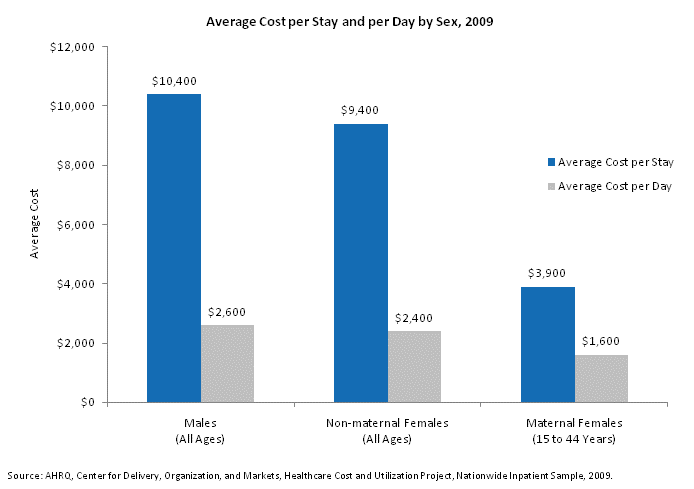TABLE OF CONTENTS
HIGHLIGHTS
INTRODUCTION
HCUP PARTNERS
1. OVERVIEW
2. DIAGNOSES
3. PROCEDURES
4. COSTS
5. WOMEN'S HEALTH
SOURCES/METHODS
DEFINITIONS
FOR MORE INFO
ACKNOWLEDGMENTS
CITATION
FACTS & FIGURES 2009 PDF
|
EXHIBIT 5.1 Overview of Female and Male Hospital Stays (PDF)
5.1a
Number of Stays and Stays per 10,000 Population by Age, Income, Region, Patient Residence, and Payer by Sex, 2009
| PRINCIPAL CCS DIAGNOSIS |
NUMBER OF STAYS IN THOUSANDS |
STAYS PER 10,000 POPULATION |
| MALES |
FEMALES |
MALES |
FEMALES |
| All stays* |
16,440 |
22,891 |
1,086 |
1,472ξ |
| Percent of all hospital stays |
42% |
58% |
- |
- |
| Age |
| < 1 year |
2,425 |
2,264 |
11,132 |
10,867 |
| 1-17 years |
775 |
813 |
216 |
237 |
| 18-44 years |
2,581 |
7,321 |
447 |
1,313ξ |
| 45-64 years |
4,790 |
4,822 |
1,236 |
1,187 |
| 65-84 years |
4,814 |
5,651 |
3,201 |
2,990ξ |
| 85+ years |
1,055 |
2,021 |
5,917 |
5,251ξ |
| Median household income of patient's ZIP Code |
| Quartile 1 (lowest) |
4,549 |
6,304 |
1,209 |
1,619ξ |
| Quartile 2 |
4,227 |
5,944 |
1,095 |
1,502ξ |
| Quartile 3 |
3,737 |
5,272 |
987 |
1,355ξ |
| Quartile 4 (highest) |
3,342 |
4,735 |
903 |
1,245ξ |
| Region |
| Northeast |
3,379 |
4,284 |
1,267 |
1,523ξ |
| Midwest |
3,758 |
5,231 |
1,143 |
1,545ξ |
| South |
6,171 |
8,974 |
1,111 |
1,561ξ |
| West |
3,132 |
4,403 |
870 |
1,224ξ |
| Patient residence |
| Large central metro |
4,838 |
6,762 |
1,081 |
1,462ξ |
| Large fringe metro |
3,804 |
5,510 |
1,036 |
1,455ξ |
| Medium and small metro |
4,329 |
6,001 |
970 |
1,306ξ |
| Micropolitan and noncore |
3,041 |
4,138 |
1,215 |
1,631ξ |
| Primary expected payer† PERCENT DISTRIBUTION |
| Medicare |
6,452 |
8,251 |
44% |
56%ξ |
| Medicaid |
2,866 |
5,130 |
36% |
64%ξ |
| Private insurance |
5,176 |
7,730 |
40% |
60%ξ |
| Uninsured** |
1,238 |
1,143 |
52% |
48% |
| Other*** |
670 |
592 |
53% |
47% |
* Excludes a small number of stays (155,000 or 0.4 percent) with missing age or sex.
ξ Female stays per 10,000 population are statistically different from male stays per 10,000 population at p<0.05. For payers, female stays are statistically different from male stays at p<0.05.
† Population denominators are not available by payer.
** Includes stays classified as self-pay or no charge.
*** Includes other payers such as Workers' Compensation, TRICARE, CHAMPUS, CHAMPVA, Title V, and other government programs.
Source: AHRQ, Center for Delivery, Organization, and Markets, Healthcare Cost and Utilization Project, Nationwide Inpatient Sample, 2009.
|
Males accounted for 42 percent of all hospital stays and females accounted for 58 percent of all hospital stays in 2009. Almost 6 out of every 10 hospital stays in 2009 were for females.
- There were 11,132 male stays and 10,867 female stays for every 10,000 children less than 1 year old in the United States in 2009, although the number of stays between sexes was similar.
- The rate of stays among 18-44 year old females was about three times the rate of similarly aged males (1,313 versus 447 stays per 10,000 population); this difference is largely due to childbirth-related hospitalizations among females.
- Among those 85 years and older, the rate of stays was higher for males than females (5,917 male stays and 5,251 female stays per 10,000 persons).
- Females were more likely to be hospitalized than males across all communities:
- In the lowest income communities, the rate of female stays was 34 percent higher than for males.
- In higher income communities, the rate for females was 37-38 percent higher than for males.
- Similarly, females were more likely to be hospitalized across all four regions:
- In the South, the rate of hospitalization for females was 41 percent higher than for males (1,561 female stays per 10,000 population compared to 1,111 male stays).
- In the West, the rate for females was also 41 percent higher than for males (1,224 female stays per 10,000 population compared to 870 male stays).
- In the Midwest, the rate of female stays was 35 percent higher than for males (1,545 versus 1,143 stays per 10,000 population).
- In the Northeast, the rate of female stays was only 20 percent higher than for males (1,523 versus 1,267 male stays per 10,000 population).
- Female rates of hospitalization were also higher than male rates across all areas of patient residence:
- The largest difference between females and males was in large fringe metro areas (suburbs), where the rate of female stays (1,455 female stays per 10,000 population) was 40 percent higher than the male rate of stays (1,036 male stays per 10,000 population).
- The rate of female stays was 34-35 percent higher than the rate of male stays in large central metro, medium and small metro, and micropolitan and noncore areas.
- In 2009, Medicare was the primary payer for 6.5 million (44 percent) male stays and 8.3 million (56 percent) female stays.
- Medicaid was the primary payer for an additional 2.9 million (36 percent) male stays and 5.1 million (64 percent) female stays. The Medicaid program covers childbirth-related stays, resulting in a large difference in the number of Medicaid stays for males and females.
- The number of uninsured stays between females and males was similar (1.1 million female stays and 1.2 million male stays).
5.1b
Number of Stays and Stays per 10,000 Population by Age, Income, Region, Patient Residence, and Payer for Maternal and Non-maternal Females,* 2009
| PRINCIPAL CCS DIAGNOSIS |
NUMBER OF STAYS IN THOUSANDS |
STAYS PER 10,000 POPULATION |
| MATERNAL FEMALES (15-44 YEARS) |
NON-MATERNAL FEMALES (ALL AGES) |
MATERNAL FEMALES (15-44 YEARS) |
NON-MATERNAL FEMALES (ALL AGES) |
| All stays** |
4,568 |
18,279 |
737 |
1,175ξ |
| Percent of all hospital stays |
12% |
46% |
- |
- |
| Age |
| 0-14 years |
- |
2,729 |
- |
902 |
| 15-19 years |
468 |
285 |
446 |
272ξ |
| 20-24 years |
1,121 |
351 |
1,073 |
336ξ |
| 25-34 years |
2,320 |
939 |
1,141 |
462ξ |
| 35-44 years |
659 |
1,480 |
319 |
716ξ |
45+ years
| - |
12,485 |
- |
1,970 |
| Median household income of patient's ZIP Code |
| Quartile 1 (lowest) |
1,191 |
5,103 |
747 |
1,311ξ |
| Quartile 2 |
1,164 |
4,771 |
737 |
1,206ξ |
| Quartile 3 |
1,077 |
4,186 |
690 |
1,075ξ |
| Quartile 4 (highest) |
1,009 |
3,714 |
681 |
977ξ |
| Region |
| Northeast |
709 |
3,566 |
643 |
1,268ξ |
| Midwest |
964 |
4,257 |
722 |
1,257ξ |
| South |
1,846 |
7,110 |
805 |
1,237ξ |
| West |
1,049 |
3,347 |
706 |
930ξ |
| Patient residence |
| Large central metro |
1,482 |
5,265 |
774 |
1,139ξ |
| Large fringe metro |
1,187 |
4,310 |
789 |
1,138ξ |
| Medium and small metro |
1,162 |
4,830 |
631 |
1,051ξ |
| Micropolitan and noncore |
680 |
3,454 |
713 |
1,362ξ |
| Primary expected payer† |
| Medicare |
29 |
8,221ξ |
- |
- |
| Medicaid |
2,044 |
3,067ξ |
- |
- |
| Private insurance |
2,169 |
5,541ξ |
- |
- |
| Uninsured*** |
198 |
942ξ |
- |
- |
| Other**** |
120 |
471ξ |
- |
- |
* Maternal female stays are hospital stays for females ages 15 to 44 who are pregnant or gave birth. Non-maternal female stays are hospital stays for females of all ages who are not pregnant and did not give birth.
** Excludes a small number of stays (155,000 or 0.4 percent) with missing age or sex.
ξ Non-maternal female stays per 10,000 population are statistically different from maternal female stays per 10,000 population at p<0.05. For payers, non-maternal female stays are statistically different from maternal female stays at p<0.05.
† Population denominators are not available by payer.
*** Includes stays classified as self-pay or no charge.
**** Includes other payers such as Workers' Compensation, TRICARE, CHAMPUS, CHAMPVA, Title V, and other government programs.
Source: AHRQ, Center for Delivery, Organization, and Markets, Healthcare Cost and Utilization Project, Nationwide Inpatient Sample, 2009.
|
- In 2009, maternal females accounted for 737 stays per 10,000 population and non-maternal females comprised 1,175 stays per 10,000 population.
- The rates of maternal stays were highest among 20 to 24 year olds and 25 to 34 year olds, as expected. The rate of non-maternal stays tended to increase by age group, with the exception of 0 to 14 year olds, a group that includes newborns. Non-maternal females 45 years and older had the highest hospitalization rate (1,970 stays per 10,000 population).
- In the poorest communities, the rate of non-maternal female stays was 75 percent higher than the rate of maternal female stays (747 maternal stays and 1,311 non-maternal stays per 10,000 population).
- Among maternal females, the rate of hospital stays in the lowest income quartile was 10 percent higher than in the highest income quartile. However, among non-maternal females, the rate of stays in the lowest income quartile was 34 percent higher than in the highest income quartile.
- The rate of non-maternal female hospitalizations was higher than the rate for maternal females across all regions:
- The greatest difference occurred in the Northeast, where the rate of non-maternal stays was 97 percent higher than the rate of maternal stays (1,268 non-maternal stays per 10,000 population versus 643 maternal stays).
- In the Midwest, the rate of non-maternal female stays was 74 percent higher than the rate of maternal female stays (1,257 non-maternal female stays per 10,000 population versus 722 maternal female stays).
- In the South, the rate of non-maternal female stays was 54 percent higher than the rate of maternal female stays (1,237 non-maternal female stays per 10,000 population versus 805 maternal female stays).
- In the West, the rate of non-maternal female stays was only 32 percent higher than the rate of maternal female stays (930 non-maternal female stays per 10,000 population versus 706 maternal female stays).
- Non-maternal females also experienced higher rates of stays than maternal females across all areas of patient residence:
- The largest difference (91 percent) in the rate of hospital stays between maternal and non-maternal females by patient residence was in micropolitan and noncore areas (713 maternal and 1,362 non-maternal stays per 10,000 population).
- In medium and small metro areas, non-maternal females had a 67-percent higher rate of stays than maternal females (631 maternal female and 1,051 non-maternal female stays per 10,000 population).
- The rate of stays among non-maternal females was 47 percent higher than the rate for maternal females in large central metro areas (774 maternal female and 1,139 non-maternal female stays per 10,000 population).
- The rate of non-maternal female stays (1,138 non-maternal female stays per 10,000 population) was 44 percent higher than the rate of maternal female stays (789 maternal female stays per 10,000 population) in large fringe metro areas.
- In 2009, private insurance was the primary payer for 2.2 million maternal stays. Medicaid was the primary payer for an additional 2.0 million maternal stays.
- Medicare was the primary payer for the greatest number of non-maternal stays (8.2 million non-maternal stays), followed by private insurance (5.5 million non-maternal stays).
5.1c 
Distribution of hospital stays by payer and sex, 2009. Column chart. Percent distribution. Males (all ages). Other: 4%; uninsured: 8%; private insurance: 31%; Medicaid: 17%; Medicare: 39%. Non-maternal females (all ages). Other: 3%; uninsured: 5%; private insurance: 30%; Medicaid: 17%; Medicare: 45%. Maternal females (15 to 44 years). Other: 3%; uninsured: 4%; private insurance: 47%; Medicaid: 45%; Medicare: 1%. Note: Other includes other payers such as Workers' Compensation, TRICARE, CHAMPUS, CHAMPVA, Title V, and other government programs. Note: Uninsured includes stays classified as self-pay or no charge. Note: Excludes a small number of stays (104,000 or 0.3%) with missing sex. Source: AHRQ, Center for Delivery, Organization, and Markets, Healthcare Cost and Utilization Project, Nationwide Inpatient Sample, 2009.
- In 2009, Medicare was the primary payer for the largest percentage of male stays (39 percent) and non-maternal female stays (45 percent).
- Because Medicare covers disabled individuals of all ages, a small share of maternal stays (1 percent) had a primary payer of Medicare.
- Forty-five percent of maternal stays had Medicaid as the primary payer. Private insurance was the primary payer for 47 percent of maternal stays.
- Private insurance was the primary payer for about 30 percent of both male and non-maternal female stays.
5.1d 
Average length of stay by sex, 1997 through 2009. Line chart. Average length of stay in days. Males (all ages). 1997: 5.2; 1998: 5.1; 1999: 5.0; 2000: 4.9; 2001: 4.9; 2002: 5.0; 2003: 4.9; 2004: 5.0; 2005: 5.0; 2006: 4.9; 2007: 5.0; 2008: 4.9; 2009: 4.9. Non-maternal females (all ages). 1997: 5.2; 1998: 5.0; 1999: 4.9; 2000: 4.8; 2001: 4.8; 2002: 4.8; 2003: 4.8; 2004: 4.8; 2005: 4.8; 2006: 4.8; 2007: 4.8; 2008: 4.8; 2009: 4.8. Maternal females (15 to 44 years). 1997: 2.5; 1998: 2.5; 1999: 2.6; 2000: 2.6; 2001: 2.6; 2002: 2.6; 2003: 2.7; 2004: 2.7; 2005: 2.7; 2006: 2.7; 2007: 2.7; 2008: 2.7; 2009: 2.7. Note: Excludes a small number of stays (104,000 or 0.3%) with missing sex. Source: AHRQ, Center for Delivery, Organization, and Markets, Healthcare Cost and Utilization Project, Nationwide Inpatient Sample, 1997-2009.
Although the average length of hospital stay declined for males and non-maternal females, the average length of hospital stay increased slightly for maternal females from 1997 to 2009.
- The average length of hospital stay for male stays decreased from 5.2 days in 1997 to 4.9 days in 2009.
- For non-maternal female stays, the average length of hospital stay decreased from 5.2 days in 1997 to 4.8 days in 2009.
- Maternal females had a slight increase in the average length of hospital stay over this time period (from 2.5 to 2.7 days), but since 2003 length of stay has been stable.
5.1e 
Average length of stay by age and sex, 2009. Column chart. Average length of stay in days. 15 to 44. Males: 4.8; non-maternal females: 4.1; maternal females: 2.7. 45 to 64. Males: 5.1; non-maternal females: 4.8. 65 to 84. Males: 5.5; non-maternal females: 5.4. 85 and over. Males: 5.6; non-maternal females: 5.4. Note: Excludes a small number of stays (104,000 or 0.3%) with missing sex. Source: AHRQ, Center for Delivery, Organization, and Markets, Healthcare Cost and Utilization Project, Nationwide Inpatient Sample, 2009.
The average length of hospital stay generally increased with age for both sexes.
- Maternal females 15 to 44 years old had an average length of hospital stay of 2.7 days, compared to 4.1 days for non-maternal females and 4.8 days for males.
- For all age groups, except 65 to 84 years old, males had a significantly longer average length of hospital stay than non-maternal females.
5.1f 
Average cost per stay and per day by sex, 2009. Column chart. Average cost. Males (all ages). Average cost per stay: $10,400; average cost per day: $2,600. Non-maternal females (all ages). Average cost per stay: $9,400; average cost per day: $2,400. Maternal females (15 to 44 years). Average cost per stay: $3,900; average cost per day: $1,600. Source: AHRQ, Center for Delivery, Organization, and Markets, Healthcare Cost and Utilization Project, Nationwide Inpatient Sample, 2009.
- On average, hospital stays for non-maternal females cost less than stays for males ($9,400 versus $10,400).
- The average cost per day of a hospital stay was about $200 less for non-maternal females than for males ($2,400 versus $2,600).
- Stays for maternal females cost an average of $3,900, less than half of the cost of a non-maternal stay.
- The average cost per day of a maternal stay was about $800 less than the average cost per day of a non-maternal stay.
5.1g 
Distribution of aggregate costs by sex, 2009. Pie chart. Percent distribution. Males (all ages): $171 billion, 47%. Non-maternal females (all ages): $172 billion, 48%. Maternal females (15 to 44 years): $18 billion, 5%. Source: AHRQ, Center for Delivery, Organization, and Markets, Healthcare Cost and Utilization Project, Nationwide Inpatient Sample, 2009.
In 2009, hospital stays in the U.S. cost a total of $361.5 billion.
- Of the 53 percent of costs attributable to stays for females, 48 percent was for non-maternal stays and 5 percent was for maternal stays.
- Overall, females accounted for a larger share of the total costs than males. However, when maternal females are excluded, females and males accounted for similar shares of total costs.
Previous Next
|




